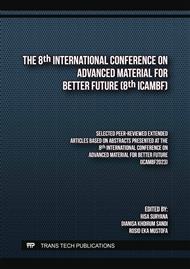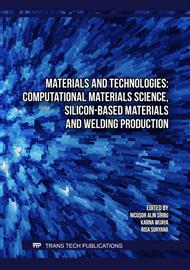[1]
Z. Gaburro, N. Daldossoh, L. Pavesi, Porous silicon, Encyclopedia of Condensed Matter Physics, (2005) 391-401.
DOI: 10.1016/b0-12-369401-9/01149-9
Google Scholar
[2]
L.A. Perelman, M.P. Schwartz, A.M. Wohlrab, M.S. VanNieuwen, M.J. Sailor, A simplified biomolecule attachment strategy for biosensing using a porous Si oxide interferometer, Phys. Stat. Sol. (A). 204(5) (2007) 1394-1398.
DOI: 10.1002/pssa.200674360
Google Scholar
[3]
S.M. Haidary, E.P. Córcoles, N.K. Ali, Nanoporous silicon as drug delivery systems for cancer therapies, J. Nanomater. 2012 (2012) 1-15.
DOI: 10.1155/2012/830503
Google Scholar
[4]
R. Moretta, L.D. Stefano, M. Terracciano, I. Rea, Porous silicon optical devices: recent advances in biosensing application, Sensors 21 (2021) 1336.
DOI: 10.3390/s21041336
Google Scholar
[5]
M. Naddaf, A. Al-Mariri, N. Haj-Mhmoud, Characterization of Ag-porous silicon nanostructured layer formed by an electrochemical etching of p-type silicon surface for bio-application, Mater. Res. Express 4 (2017) 065013.
DOI: 10.1088/2053-1591/aa6eda
Google Scholar
[6]
H. Foll, M. Christophersen, J. Carstensen, G. Hasse, Formation and application of porous silicon, Mater. Sci. Eng. R: Reports 39(4) (2002) 93-141.
DOI: 10.1016/s0927-796x(02)00090-6
Google Scholar
[7]
X. Sun, P. Sharma, G. Parish, A. Keating, Enabling high-porosity porous silicon as an electronic material, Microporous and Mesoporous Materials 312 (2021) 110808.
DOI: 10.1016/j.micromeso.2020.110808
Google Scholar
[8]
R. Bellotti, G.B. Picotto, L. Ribotta, AFM measurements and tip characterization of nanoparticles with different shapes, Manufacturing and Metrology 5 (2022) 127-138.
DOI: 10.1007/s41871-022-00125-x
Google Scholar
[9]
M. Handayani, N.D. Pratiwi, R. Suryana, Optical absorbance of porous silicon on n-type Si (111) surfaces fabricated by electrochemical anodization method, Material Today: Proceedings 13(1) (2019) 87-91.
DOI: 10.1016/j.matpr.2019.03.193
Google Scholar
[10]
Sehati, S. Wijayanti, R. Suryana, Variation of etching time on formation of porous silicon on p-type Si (111) using electrochemical anodization method, J. Phys.: Conf. Ser. 1825 (2021) 012067.
DOI: 10.1088/1742-6596/1825/1/012067
Google Scholar
[11]
B. Pratama, I. Syahidi, E. Prayogo, K. Triyanta, Khairurrijal, H. Susanto, R. Suryana, Formation of porous silicon on N-type Si (1 0 0) and Si (1 1 1) substrates by electrochemical anodization method, Material Today: Proceedings 44(3) (2021) 3426-3429.
DOI: 10.1016/j.matpr.2021.02.832
Google Scholar
[12]
R. Suryana, N.Q. Aini, Analysis of porous silicon formation on n-type si (100) using laser-assisted electrochemical anodization method, Journal of Physics and Its Applications 4(2) (2022) 28-32.
DOI: 10.14710/jpa.v4i2.12664
Google Scholar
[13]
S. Rahmouni, L. Zighed, Applications of silicon photonics in sensors and waveguides, in: L.N.D. Kallepalli, Experimental study of porous silicon films, Intechopen, 2018, pp.47-62.
DOI: 10.5772/intechopen.74479
Google Scholar
[14]
L. Canham, Handbook of Porous Silicon, in: L. Canham (Ed.), Color of porous silicon, Springer International Publishing, Kyoto, 2014, p.255–262.
DOI: 10.1007/978-3-319-05744-6_27
Google Scholar
[15]
G. Marsh, Power silicon a useful imperfection, Materials Today 5(1) (2002) 36-41.
Google Scholar
[16]
F. Kabarsian, Porosity-process, technologies and applications, in: T.H. Ghrib, Porous silicon, Intechopen, London, United Kingdom, 2018, pp.3-36.
Google Scholar
[17]
X.G. Zhang, S.D. Collins, R.L. Smith, Porous silicon formation and electropolishing of silicon by anodic polarization in HF solution, J. Electrochem. Soc. 136(5) (1989) 1561-1565.
DOI: 10.1149/1.2096961
Google Scholar



